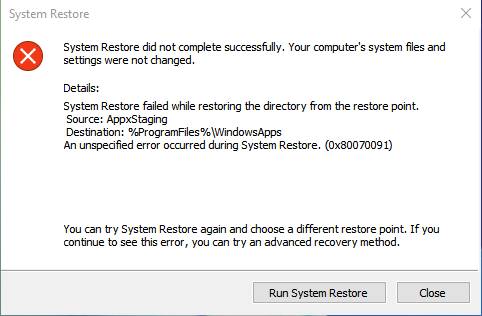 Microsoft's cumulative January 2017 update KB3213986 seems to cause a serious issue in Windows 10 Anniversary Update. After installing this update, system restore fails with error 0x80070091.
Microsoft's cumulative January 2017 update KB3213986 seems to cause a serious issue in Windows 10 Anniversary Update. After installing this update, system restore fails with error 0x80070091.
Advertising
I've addressed this error within my blog post Windows 10 Version 1607: System restore error 0x80070091 [Fix] a few days ago. Trying to execute a system restore ends after a "long time" with error message 0x80070091.

During investigating this issue, I came to a conclusion, that update KB3213986 is involved. Some of my German readers came back with a comment, that NTFS links within WindowsApps subfolders may be the cause for this issue. One user mentioned VFS sub folders as the root cause (couldn't be deleted). I searched the web and found some mention of VFS for App-V, desktop brigde and Hyper-V. The changelog for cumulative January 2017 update KB3213986 mentions also fixes in Hyper-V and App-V.
Last weekend I spended several hours to test some things. As a conclusion, I identified KB3213986 as involved into this issue, but It's not sufficient to uninstall this update to fix the bug. The advices given within my blog post Windows 10 Version 1607: System restore error 0x80070091 [Fix] are still required. At this point I gave up to do further tests (I ran out of time).
But I've posted my assumptions within MS Answers forum, and Gegory Livingston confirmed now the following.
Advertising
- It is update KB3213986 that causes the problem to occur in the first instance.
- Rolling back the update does not correct the problem.
- Performing the known fix returns System Restore functionality.
- For how long, we don't yet know.
Well, that's odd. As I wrote within the MS answers forum thread: System restore seems to be terrible broken from time to time; Windows backup isn't reliable; and I came across forum posts, where restoring Windows 10 using recovery fails also with error 0x80070091. So as a Windows 10 user, you are forced to use a third party backup tool (Macrium reflection, ToDo Backup etc.) to create system backups on a periodical base, in the hope, that you are able to restore a damaged OS. Happy new Windows 10 world – isn't it?








Hello, can you please define: "Windows backup isn't reliable"
I have only best experience with Windows Backup (wbadmin)
Thank you.
Well wbadmin is another thing than "Windows 7 backup". wbadmin seems to be a bit more robust – but if you have some issue with VSS, if you have the wrong Win PE build and so on, you are nailed to read your images back. It's the experience I gained from several years acting as community moderator in Microsoft Answers.
Hello, Wbadmin = Windows 7 backup = Windows Server Backup. Its all wbadmin with different writers (for example for sql, hyper-v…)
If you set up Windows 7 backup in GUI, Windows will create wbadmin taks in Task Scheduler
And another advantages of Windows Backups are that created backup is simply VHD of disk. You can manually mount it if something go wrong.
But I agree with you that restoring in "Win PE" is sometimes painful :)
Have a nice day!
A quote from glivo @ 10forum that got me back on the road:
1-Boot into safe mode;
2-Right click on the start button, left click on Command Prompt (Admin)
Window will appear with a Command Prompt ending with >
3-Keyboard: takeown /f "C:\Program Files\WindowsApps" /r /d Y
Press Enter. Wait for it to finish and go back to Command Prompt>
4-Keyboard: [I]icacls "C:\Program Files\WindowsApps" /grant "%USERDOMAIN%\%USERNAME%":(F) /t[/I]
Press Enter. You will get a message: Successfully processed xxxxx files: Failed to process 0 files
5- Keyboard: rd /s "C:\Program Files\Windows Apps"
Press Enter. It will ask you to confirm. Yes. This will delete the folder. OR
rename "C:\Program Files\Windows Apps" "C:\Program Files\Windows Apps(old)"
if you prefer to rename it. I found that the rename option didn't work.
6- Now Reboot your computer and System Restore should work.
So you understand what is going on.
Step 3: As the current user, you are taking Ownership of the \WindowsApps directory and everything in it.
Step 4: You are granting the current user Full Control over that directory.
Step 5: You are deleting the directory and everything in it.
Well, the rename command didn't work, because the file is still hidden/system – as explained within my linked blog post Windows 10 Version 1607: System restore error 0x80070091 [Fix].
In #5, it should read WindowsApps (no space) in both instances.
Ref Me Again: Wow, what a coincidence, I put that up nearly 3 years ago!
(simpk5)
Pingback: Windows 10 update KB 3213986 triggers System Restore error 0x80070091 - Gizmo Effect
LITERALLY NONE of this works.
How could this happen!?! Mandatory updates are one thing, but to have one of those updates break my computer? Microsoft is rolling downhill like a snowball headed for hell. Nothing but junky CRAP being produced by this company now. Too bad it's my only option since I'm computer illiterate. Incidentally, I wanted to say this same thing at answers.microsoft.com but could log into my account.
I meant to say "couldn't log into my account."
http://h30434.www3.hp.com/t5/Notebook-Operating-System-and-Recovery/C-Windows-WinSxS-Temp-PendingRenames/td-p/3183223
I have some of these. Maybe helps explain something?
I just had the same problem. It began when the latest Windows 10 update messed up my OS, so that after logging in, I get a blank/black screen with just the mouse cursor.
I was able to use Ctrl-Alt-Del to open up the task manager, and from there run a few apps (using Run from the File menu). I could also run MSConfig and from there launch the System Restore. However, that was where I ran into the problem described above: all attempts at going back to restore points failed. I used Born's steps to remedy this and was just now able to successfully restore to a January restore point. However, after logging in, I still get the black screen (no GUI)!! How is this possible, if it restored an earlier copy of Windows? Searches reveal that others are encountering this problem too. Does anyone have any suggestions? I created an ISO disc from another PC — shall I run that? Will it lose my installed apps?
I am desperately trying to get windows 10 working again without having to reinstall all my applications. That is a big process, plus they have to be reauthorized, etc.
Windows 10 updates crushed my OS three times last year, requiring me to go through the hell of reinstalling everything. I can't keep doing this! What a horrible unstable OS Windows 10 has turned out to be. After the travesty of Windows 8, I was pleased that Windows 10 had cleaned things up, usabilty-wise, but this instability is unprecedented!
Fear you have to reset Win10 and re-install all apps. Win10 is a nasty thing, and I'm using it only within a test environment. My production machines are on Windows 7 (and will stay at this OS till 2020).
I wonder if some one could answer this question for me-will replaceing the hard drive get rid of the system restore problem? or will it just come back again when I reinstall windows 10 and the corrupt update reloads?
all of the fixes listed above are over my head but I do know how to replace the drive.
thanks for any help.
Currently I havent't the time to test (an emergency case within my family has grounded me since a week). But from what I read in several MS Answers forum threads (where I'm also involved) brought me to the conclusion, that this error will come back. After I (I'm a community moderator, and others, I guess) has escalated this issue, Microsoft has confirmed that problem and investigate it (see).
I just came accross this post after trying to find a solution to this nightmare. Last Windows 1o update cleaned my desktop where I had a few files and important folders. I do not see any windows.old folder or subfolder and after trying different approaches to find these files and folders with no luck I wonder where windows could have relocated them? or where just deleted from the system all of a sudden? When doing a system restore get same error over and over 0x80070091. Please Help!
If there is no Windows.old, the files are gone. BTW: User files are not affected by system restore – so it's useless to hope, system restore will recover lost user files (imho).
None of the commands work
Thank you for your help. I was stuck at System Restore too, with the AppxStaging problem. I managed to rename WindowsApps as you suggested, rebooted and tried System Restore again but this time it said it had failed to find an operating system to restore. Without that I could go no further. I tried bootrec from command prompt, but it could not "/RebuildBcd" saying it couldn't find the file. In desperation I changed the Legacy boot in BIOS to UEFI boot (I had altered this last year after a different problem) and for some reason after a reboot, System Restore now found an operating system AND (joy) ran System Restore successfully. This might help someone else.